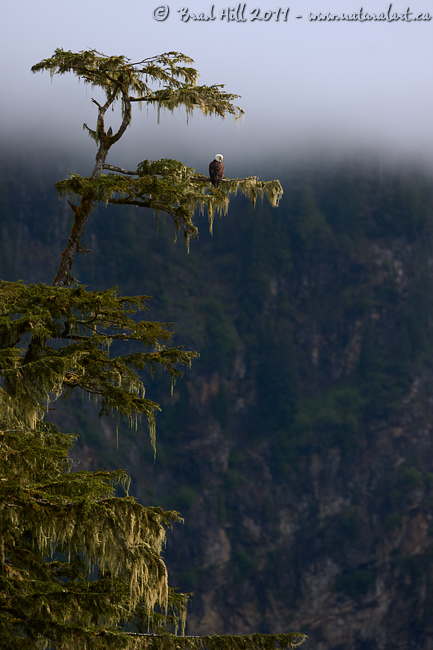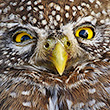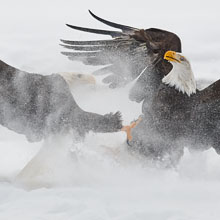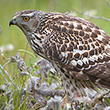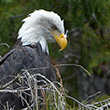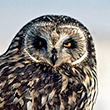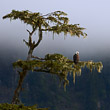Availability: Undetermined - Enquiries?
In the Field
The Sentinel. Khutzeymateen Inlet (Great Bear Rainforest), BC, Canada. May 29, 2011.
While the Khutzeymateen Inlet on the northern BC coast is primarily known for its grizzlies, there's a whole lot more to the Khutzeymateen than bears! The area teems with birdlife in all shapes and sizes, deer, otters, mink, seals, coastal wolves, and more! I nabbed this image as we were traveling into the estuary at the head of the inlet - I'm not sure what made me look up so high (it WAS a grizzly photo tour and it's pretty rare to see a griz hundreds of feet up in a tree!), but when I glimpsed this scene unfolding (as the mist was rising and the sun filtering through and kissing the tree and the eagle) I have to admit that for a few moments bears WEREN'T on my mind!
The only "trick" to capturing this image was ensuring that I didn't blow out the highlights on the eagle's head. With Nikon's Matrix Metering system (and Canon's Evaluative system), if a region of near white occupies only a small portion of the total scene and that scene is neutral gray or darker, odds are the exposure "suggestion" of the camera will produce an image with the whites "blown-out" (i.e., over-exposed). I knew this and instinctively pulled my exposure back by a full stop before shooting (I almost always use Matrix as my exposure meter mode).
Oh...and one last thing. If I have a favourite tree on the planet, it would be the tree the eagle is perched on. And I like BOTH ends of the tree - back in 2006 I photographed a female grizzly with 3 cubs swimming across a channel at the base of the tree which has sold very well (the image is named Misty Morning Dip - see it here) and I kinda like how this shot came together at the top of the tree! So if you ever go to the Khutzeymateen, ask Tom (the bear guide) to point out "Brad's Tree" - he'll know what you mean. And then watch both ends of it!
NOTE: This image was captured in a region of British Columbia known as "The Great Bear Rainforest". Each year I offer trips into two different parts of the Great Bear Rainforest as well as one to photograph aquatic mammals and oceanscapes near the northern tip of Vancouver Island. And, in selected years, I also offer photo tours to locations to capture other highly sought-after subjects, such as various boreal owl species and wildlife of Canada's Arctic. Details about these trips can be found on the Photo Tours page of this website.
Behind the Camera
The Sentinel. Khutzeymateen Inlet (Great Bear Rainforest), BC, Canada. May 29, 2011.
Digital Capture; RAW 14-bit format; ISO 200.
Nikon D3s with Nikkor 400mm f2.8 VR lens. Hand-held from floating Zodiac inflatable boat (VR on and in normal mode).
1/1250s @ f5.6; -1.0 stop compensation from matrix-metered exposure setting.
At the Computer
The Sentinel. Khutzeymateen Inlet (Great Bear Rainforest), BC, Canada. May 29, 2011.
RAW Conversion to 16-bit TIFF, including first-pass/capture sharpening using Phase One's Capture One Pro 6. Three raw conversions varying in exposure settings over a 0.8 stop range (-0.5 stops from original capture exposure setting to +0.3 stops from capture settings).
Further digital corrections on 16-bit TIFF file using Adobe's Photoshop CS5. Photoshop adjustments including blending of 3 exposure versions, selective exposure and tone curve adjustment, selective colour saturation, and selective sharpening for web output. Light cooling filter (15%) added to mist at top of image (selectively added using luminosity mask).
Conservation
The Sentinel. Khutzeymateen Inlet (Great Bear Rainforest), BC, Canada. May 29, 2011.
Ten percent of the revenue generated by this image will be donated to Raincoast.
Species Status in Canada*: This species is not designated as at risk. The Bald Eagle was listed as "Endangered" in the contiguous US states from 1967 to 1995. In 1995 it was downlisted to "Threatened". On June 28, 2007 Bald Eagles were removed from the list of endangered and threatened species - a true American conservation success story.
The Bald Eagle (Haliaeetus leucocephalus) is a very large bird of prey with broad wings. Adults possess characteristic white ("bald") heads. It takes Bald Eagles a full five years to attain their characteristic adult plumage (including their nearly pure white head and tail). In the years prior to the development of their adult plumage they are easy to confuse with Golden Eagles. Being very broad-winged Bald Eagles are able to use an energy-efficient flapping-soaring style of flight. While many people like to think of the Bald Eagle as a fierce hunter, in reality they hunt only as a last resort. More commonly they scavenge for their prey. Additionally, they often klepto-parasitize other weaker species such as Osprey, commonly stealing the other species hard-earned prey items. The Bald Eagle is, of course, the national emblem of the United States (Benjamin Franklin argued against this - his preference was for the Wild Turkey).
This Bald Eagle was photographed in the heart of the Great Bear Rainforest. While Bald Eagles are currently not under the threat of extinction, they do, of course, require suitable breeding habitat to continue to thrive. The Raincoast Conservation Society (and Foundation) is an effective and efficient organization that has been fighting for protection of this unique habitat. If you are looking for a meaningful way to contribute to the conservation of this amazing ecosystem, Raincoast will provide maximal "bang" for your conservation dollars.
*as determined by COSEWIC: The Committee on the Status of Endangered Wildlife in Canada













